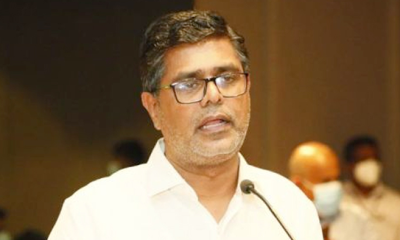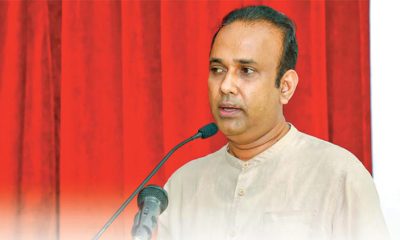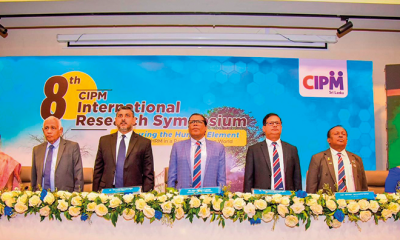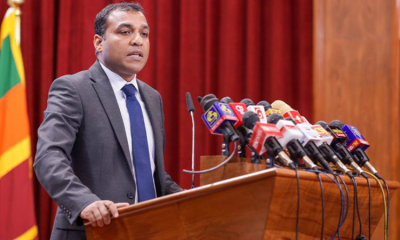Features
Aragalaya agenda after Ranil
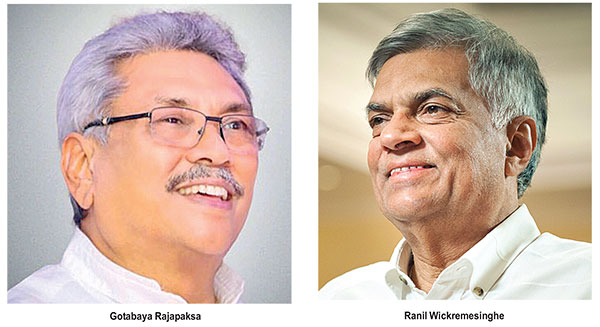
By DR. DAYAN JAYATILLEKA
When history is written, it must not be said that the greatest achievement of the Aragalaya was to make Ranil Wickremesinghe, an unelected MP and leader of the UNP which was rejected utterly by the people, the Prime Minister for the 6th time.Of course, the Aragalaya got rid of Mahinda Rajapaksa, but he was succeeded by Ranil Wickremesinghe. The proof of the pudding is in the eating.That cannot be the final outcome, the last word, on the Aragalaya. There must be some victory which is in accordance with the values, demands and ideals of the Aragalaya. The Aragalaya is the best thing that happened to us, the best thing we did as a country certainly since the war ended in victory. If the war was won, thanks to the Rajapaksas and Sarath Fonseka, peace was lost also, thanks to the Rajapaksas. We had hit rock bottom when the Aragalaya resurrected us as a country; a people a society.If the Aragalaya loses its way or worse still dissipates, we would have lost the best of ourselves, as a society.Therefore, with the Aragalaya now at a crossroads, a course correction is needed.
Every course correction starts with an honest audit or a self-criticism as the left calls it, though the Lankan left hardly ever engages in a sincere one.The Trap the Aragalaya Fell IntoIn the struggle to save the Gotabaya Presidency, a tactic was obviously devised by the deep State to divert the campaign to another target. The first was Basil Rajapaksa, the second was the Prime Minister Mahinda Rajapaksa. Elements of the 11-party bloc fell for that and presented solutions which shifted the focus to the PM.From Gota’s Gotta Go, the struggle either was diverted to Mahinda or enlarged and therefore diluted to include the PM. When you enlarge a target to include a new element, you lose focus. Ask any sniper or simply any marksman.The Aragalaya fell into the trap and it was NOT on May 9th when MR’s thugs went on a rampage. It was earlier. Ironically the mistake was made by the most dedicated, heroic, indispensable detachment of the Aragalaya, the Inter-University Student’s Federation (IUSF) and its sincere leader Wasantha Mudalige.The IUSF staged a massive, impressive march to Galle Face Green. The Police placed roadblocks, including ones with spikes. As we saw at the conclusion of the march though, the Galle Road was open as the point of access. Having made some smart tactical moves and built-up considerable momentum and velocity, the IUSF march made a detour to Temple Trees and at one point tried to get past the barricades and shake the gates. Promising to return, the march triumphantly made it to Galle Face green, which it could have done without that detour.That night ‘MynahGoGama’ came up, which was cool. Mahinda Rajapaksa responded crudely with Pirith blaring and the rest of it. May 9th came afterwards.
By the detour, the struggle with the PM became the most dramatic. In terms of tactics and strategy, that detour was a deviation. It was to prove expensive. On May 9th the Aragalaya won that battle but damaged the war against the Gotabaya autocracy and the Rajapaksa oligarchy.The thing is, Gota and Mahinda together gave the picture of a Rajapaksa oligarchy, which was the reality. Re-targeting the struggle to Mahinda was exactly what the Gota camp wanted. Mahinda’s stupidity enabled Gota to dump him and activate the Rajapaksas’ Plan B: Ranil Wickremesinghe.It would be a naïve person to believe that Ranil’s return to Parliament was not as part of an agreement with Mahinda and with the blessings of Gota. Ranil was kept as UNP leader even by CBK as a safe reserve option.On May 9th-May 10th, the Rajapaksas activated Plan B and installed their ally Ranil Wickremesinghe as Prime Minister. That outcome is hardly an outstanding revolutionary victory. It is in fact a retro-move; in other words, it is historically a step backward.So, what about Sajith Premadasa and the SJB? I think that two mistakes were made, by both the Aragalaya and the SJB.Once Mahinda was pushed out, the Aragalaya should have insisted that the Opposition Leader take the Prime Ministership, because it would have been much better to have a quasi-ally of the Aragalaya as PM and dominating the Cabinet than having Ranil do so, and transitioning Gotabaya out by reformist ‘salami tactics’ such as the 19th Amendment, while protecting the people’s living standards in negotiations with the INF and creditors.
Instead, some elements in the Aragalaya (and I believe they have been identified as NOT being MR thugs, Police/military spies or Peratugamee/IUSF activists) initiated a mob attack on Sajith Premadasa.On the night of May 9th, the Aragalaya leaders made a second strategic mistake, that of silence. While it may be said that regime provocateurs were responsible for violence in the provinces, what was going on at Temple Trees was utterly transparent and could have been parametrically restrained. That is what leadership is about. As Lenin said, ‘any real communist must know how to start a strike as well as how to stop it’.
SJB’s Delay
As for the SJB itself, it has to make an existential choice. It has to decide “Api Kavuruda”: whether it is a tough-minded, hard-charging Premadasist populist/social democratic party or a party dominated or influenced by liberals ( mainly liberal constitutional lawyers), most of whom were Ranil followers, bond scam foot-noters, Berghof Foundation products who supported Ranil’s CFA with Prabhakaran, assorted federalists, lawyers for Ranil in the Bond scam case and drafters of new Constitutions for Ranil going against the 1978 Presidential Constitution that their own fathers drafted.The SJB delayed by wasting time for weeks with a slogan of ‘abolition of the executive presidency’ which could not secure the SLFP’s support and was more of a load than the moment could bear.The SJB’s bad timing and slow intervention reminded me of the line of Carl Schmitt (whose formative background was Catholic, not evangelical) that “when faced with the choice ‘Jesus or Barabbas’, liberals appoint a committee!” His famous point was that liberalism, and especially liberal parliamentarism (devoid of a strong executive), was incapable of making a decision in crisis. The ‘decisionist’ critique of liberalism was proved by the SJB which delayed and miscalculated the actual balance of forces at a decisive moment.
Aragalaya Agenda, post-Ranil
So, what next for the Aragalaya? Slavoj Zizek wrote that “The Revolution Always Rings Twice”. It was a riff on the movie the Postman Always Rings Twice, and referred in this case to the Russian revolution of 1917 which actually witnessed TWO revolutions, in February and in October. Zizek’s point was that Lenin went against the tide and pushed through the second most decisive revolution within the year.Now the Aragalaya has not even won the February 1917 revolution i.e., the democratic revolution that ousted the Tsar of Russia. Instead, Tsar Gotabaya is still there, while he has a new PM. Therefore, there is no question of a second (this time, socialist) ‘October’ revolution. The democratic revolution must be brought to completion and crowned by the departure of Gotabaya. However, the Zizekian point about Lenin is valid in that there can and must be a Second Wave of the (democratic) Revolution to carry it through to completion and do so within this year.Here too, Zizek’s determined, resolute, hard-driving Lenin must be ‘read’ together with Georg Lukacs’ Lenin. Lukacs writes in 1924 of “Lenin’s realism, his Realpolitik…”
The Aragalaya must now have a three-point agenda UNDER, NOT INSTEAD OF the ‘Gota Go Home’ thematic slogan and intended as the concrete way to operationalize that slogan in the new conditions of Ranil’s PM-ship.:
1. Articulate a minimum economic programme to defend and restore the living standards of the people in the face of any attempt to impose the burden of economic crisis management and recovery on those who had nothing to do with starting the crisis. This programme must commence with the immediate restoration of the fertiliser subsidy.
2. Convene a roundtable conversation of all Aragalaya and Opposition forces and draft an Aragalaya+ Opposition Consensus platform. It requires a broad Church or Big Tent inclusionary approach such as the conventions that Sub-Comandante Marcos and the Zapatistas had in liberated Chiapas and the Sau Paulo Forum initiated by Lula as Mayor. My strong suggestion is do not go for the abolition of the executive presidency. It can easily be defeated at a referendum by showing that the executive presidency is indispensable in economic crisis, and anyway, the military may react against it.
3. Focus on an irresistible campaign for Parliamentary, Presidential elections within this year.
Features
The heart-friendly health minister

by Dr Gotabhya Ranasinghe
Senior Consultant Cardiologist
National Hospital Sri Lanka
When we sought a meeting with Hon Dr. Ramesh Pathirana, Minister of Health, he graciously cleared his busy schedule to accommodate us. Renowned for his attentive listening and deep understanding, Minister Pathirana is dedicated to advancing the health sector. His openness and transparency exemplify the qualities of an exemplary politician and minister.
Dr. Palitha Mahipala, the current Health Secretary, demonstrates both commendable enthusiasm and unwavering support. This combination of attributes makes him a highly compatible colleague for the esteemed Minister of Health.
Our discussion centered on a project that has been in the works for the past 30 years, one that no other minister had managed to advance.
Minister Pathirana, however, recognized the project’s significance and its potential to revolutionize care for heart patients.
The project involves the construction of a state-of-the-art facility at the premises of the National Hospital Colombo. The project’s location within the premises of the National Hospital underscores its importance and relevance to the healthcare infrastructure of the nation.
This facility will include a cardiology building and a tertiary care center, equipped with the latest technology to handle and treat all types of heart-related conditions and surgeries.
Securing funding was a major milestone for this initiative. Minister Pathirana successfully obtained approval for a $40 billion loan from the Asian Development Bank. With the funding in place, the foundation stone is scheduled to be laid in September this year, and construction will begin in January 2025.
This project guarantees a consistent and uninterrupted supply of stents and related medications for heart patients. As a result, patients will have timely access to essential medical supplies during their treatment and recovery. By securing these critical resources, the project aims to enhance patient outcomes, minimize treatment delays, and maintain the highest standards of cardiac care.
Upon its fruition, this monumental building will serve as a beacon of hope and healing, symbolizing the unwavering dedication to improving patient outcomes and fostering a healthier society.We anticipate a future marked by significant progress and positive outcomes in Sri Lanka’s cardiovascular treatment landscape within the foreseeable timeframe.
Features
A LOVING TRIBUTE TO JESUIT FR. ALOYSIUS PIERIS ON HIS 90th BIRTHDAY

by Fr. Emmanuel Fernando, OMI
Jesuit Fr. Aloysius Pieris (affectionately called Fr. Aloy) celebrated his 90th birthday on April 9, 2024 and I, as the editor of our Oblate Journal, THE MISSIONARY OBLATE had gone to press by that time. Immediately I decided to publish an article, appreciating the untiring selfless services he continues to offer for inter-Faith dialogue, the renewal of the Catholic Church, his concern for the poor and the suffering Sri Lankan masses and to me, the present writer.
It was in 1988, when I was appointed Director of the Oblate Scholastics at Ampitiya by the then Oblate Provincial Fr. Anselm Silva, that I came to know Fr. Aloy more closely. Knowing well his expertise in matters spiritual, theological, Indological and pastoral, and with the collaborative spirit of my companion-formators, our Oblate Scholastics were sent to Tulana, the Research and Encounter Centre, Kelaniya, of which he is the Founder-Director, for ‘exposure-programmes’ on matters spiritual, biblical, theological and pastoral. Some of these dimensions according to my view and that of my companion-formators, were not available at the National Seminary, Ampitiya.
Ever since that time, our Oblate formators/ accompaniers at the Oblate Scholasticate, Ampitiya , have continued to send our Oblate Scholastics to Tulana Centre for deepening their insights and convictions regarding matters needed to serve the people in today’s context. Fr. Aloy also had tried very enthusiastically with the Oblate team headed by Frs. Oswald Firth and Clement Waidyasekara to begin a Theologate, directed by the Religious Congregations in Sri Lanka, for the contextual formation/ accompaniment of their members. It should very well be a desired goal of the Leaders / Provincials of the Religious Congregations.
Besides being a formator/accompanier at the Oblate Scholasticate, I was entrusted also with the task of editing and publishing our Oblate journal, ‘The Missionary Oblate’. To maintain the quality of the journal I continue to depend on Fr. Aloy for his thought-provoking and stimulating articles on Biblical Spirituality, Biblical Theology and Ecclesiology. I am very grateful to him for his generous assistance. Of late, his writings on renewal of the Church, initiated by Pope St. John XX111 and continued by Pope Francis through the Synodal path, published in our Oblate journal, enable our readers to focus their attention also on the needed renewal in the Catholic Church in Sri Lanka. Fr. Aloy appreciated very much the Synodal path adopted by the Jesuit Pope Francis for the renewal of the Church, rooted very much on prayerful discernment. In my Religious and presbyteral life, Fr.Aloy continues to be my spiritual animator / guide and ongoing formator / acccompanier.
Fr. Aloysius Pieris, BA Hons (Lond), LPh (SHC, India), STL (PFT, Naples), PhD (SLU/VC), ThD (Tilburg), D.Ltt (KU), has been one of the eminent Asian theologians well recognized internationally and one who has lectured and held visiting chairs in many universities both in the West and in the East. Many members of Religious Congregations from Asian countries have benefited from his lectures and guidance in the East Asian Pastoral Institute (EAPI) in Manila, Philippines. He had been a Theologian consulted by the Federation of Asian Bishops’ Conferences for many years. During his professorship at the Gregorian University in Rome, he was called to be a member of a special group of advisers on other religions consulted by Pope Paul VI.
Fr. Aloy is the author of more than 30 books and well over 500 Research Papers. Some of his books and articles have been translated and published in several countries. Among those books, one can find the following: 1) The Genesis of an Asian Theology of Liberation (An Autobiographical Excursus on the Art of Theologising in Asia, 2) An Asian Theology of Liberation, 3) Providential Timeliness of Vatican 11 (a long-overdue halt to a scandalous millennium, 4) Give Vatican 11 a chance, 5) Leadership in the Church, 6) Relishing our faith in working for justice (Themes for study and discussion), 7) A Message meant mainly, not exclusively for Jesuits (Background information necessary for helping Francis renew the Church), 8) Lent in Lanka (Reflections and Resolutions, 9) Love meets wisdom (A Christian Experience of Buddhism, 10) Fire and Water 11) God’s Reign for God’s poor, 12) Our Unhiddden Agenda (How we Jesuits work, pray and form our men). He is also the Editor of two journals, Vagdevi, Journal of Religious Reflection and Dialogue, New Series.
Fr. Aloy has a BA in Pali and Sanskrit from the University of London and a Ph.D in Buddhist Philosophy from the University of Sri Lankan, Vidyodaya Campus. On Nov. 23, 2019, he was awarded the prestigious honorary Doctorate of Literature (D.Litt) by the Chancellor of the University of Kelaniya, the Most Venerable Welamitiyawe Dharmakirthi Sri Kusala Dhamma Thera.
Fr. Aloy continues to be a promoter of Gospel values and virtues. Justice as a constitutive dimension of love and social concern for the downtrodden masses are very much noted in his life and work. He had very much appreciated the commitment of the late Fr. Joseph (Joe) Fernando, the National Director of the Social and Economic Centre (SEDEC) for the poor.
In Sri Lanka, a few religious Congregations – the Good Shepherd Sisters, the Christian Brothers, the Marist Brothers and the Oblates – have invited him to animate their members especially during their Provincial Congresses, Chapters and International Conferences. The mainline Christian Churches also have sought his advice and followed his seminars. I, for one, regret very much, that the Sri Lankan authorities of the Catholic Church –today’s Hierarchy—- have not sought Fr.
Aloy’s expertise for the renewal of the Catholic Church in Sri Lanka and thus have not benefited from the immense store of wisdom and insight that he can offer to our local Church while the Sri Lankan bishops who governed the Catholic church in the immediate aftermath of the Second Vatican Council (Edmund Fernando OMI, Anthony de Saram, Leo Nanayakkara OSB, Frank Marcus Fernando, Paul Perera,) visited him and consulted him on many matters. Among the Tamil Bishops, Bishop Rayappu Joseph was keeping close contact with him and Bishop J. Deogupillai hosted him and his team visiting him after the horrible Black July massacre of Tamils.
Features
A fairy tale, success or debacle

Sri Lanka-Singapore Free Trade Agreement
By Gomi Senadhira
senadhiragomi@gmail.com
“You might tell fairy tales, but the progress of a country cannot be achieved through such narratives. A country cannot be developed by making false promises. The country moved backward because of the electoral promises made by political parties throughout time. We have witnessed that the ultimate result of this is the country becoming bankrupt. Unfortunately, many segments of the population have not come to realize this yet.” – President Ranil Wickremesinghe, 2024 Budget speech
Any Sri Lankan would agree with the above words of President Wickremesinghe on the false promises our politicians and officials make and the fairy tales they narrate which bankrupted this country. So, to understand this, let’s look at one such fairy tale with lots of false promises; Ranil Wickremesinghe’s greatest achievement in the area of international trade and investment promotion during the Yahapalana period, Sri Lanka-Singapore Free Trade Agreement (SLSFTA).
It is appropriate and timely to do it now as Finance Minister Wickremesinghe has just presented to parliament a bill on the National Policy on Economic Transformation which includes the establishment of an Office for International Trade and the Sri Lanka Institute of Economics and International Trade.
Was SLSFTA a “Cleverly negotiated Free Trade Agreement” as stated by the (former) Minister of Development Strategies and International Trade Malik Samarawickrama during the Parliamentary Debate on the SLSFTA in July 2018, or a colossal blunder covered up with lies, false promises, and fairy tales? After SLSFTA was signed there were a number of fairy tales published on this agreement by the Ministry of Development Strategies and International, Institute of Policy Studies, and others.
However, for this article, I would like to limit my comments to the speech by Minister Samarawickrama during the Parliamentary Debate, and the two most important areas in the agreement which were covered up with lies, fairy tales, and false promises, namely: revenue loss for Sri Lanka and Investment from Singapore. On the other important area, “Waste products dumping” I do not want to comment here as I have written extensively on the issue.
1. The revenue loss
During the Parliamentary Debate in July 2018, Minister Samarawickrama stated “…. let me reiterate that this FTA with Singapore has been very cleverly negotiated by us…. The liberalisation programme under this FTA has been carefully designed to have the least impact on domestic industry and revenue collection. We have included all revenue sensitive items in the negative list of items which will not be subject to removal of tariff. Therefore, 97.8% revenue from Customs duty is protected. Our tariff liberalisation will take place over a period of 12-15 years! In fact, the revenue earned through tariffs on goods imported from Singapore last year was Rs. 35 billion.
The revenue loss for over the next 15 years due to the FTA is only Rs. 733 million– which when annualised, on average, is just Rs. 51 million. That is just 0.14% per year! So anyone who claims the Singapore FTA causes revenue loss to the Government cannot do basic arithmetic! Mr. Speaker, in conclusion, I call on my fellow members of this House – don’t mislead the public with baseless criticism that is not grounded in facts. Don’t look at petty politics and use these issues for your own political survival.”
I was surprised to read the minister’s speech because an article published in January 2018 in “The Straits Times“, based on information released by the Singaporean Negotiators stated, “…. With the FTA, tariff savings for Singapore exports are estimated to hit $10 million annually“.
As the annual tariff savings (that is the revenue loss for Sri Lanka) calculated by the Singaporean Negotiators, Singaporean $ 10 million (Sri Lankan rupees 1,200 million in 2018) was way above the rupees’ 733 million revenue loss for 15 years estimated by the Sri Lankan negotiators, it was clear to any observer that one of the parties to the agreement had not done the basic arithmetic!
Six years later, according to a report published by “The Morning” newspaper, speaking at the Committee on Public Finance (COPF) on 7th May 2024, Mr Samarawickrama’s chief trade negotiator K.J. Weerasinghehad had admitted “…. that forecasted revenue loss for the Government of Sri Lanka through the Singapore FTA is Rs. 450 million in 2023 and Rs. 1.3 billion in 2024.”
If these numbers are correct, as tariff liberalisation under the SLSFTA has just started, we will pass Rs 2 billion very soon. Then, the question is how Sri Lanka’s trade negotiators made such a colossal blunder. Didn’t they do their basic arithmetic? If they didn’t know how to do basic arithmetic they should have at least done their basic readings. For example, the headline of the article published in The Straits Times in January 2018 was “Singapore, Sri Lanka sign FTA, annual savings of $10m expected”.
Anyway, as Sri Lanka’s chief negotiator reiterated at the COPF meeting that “…. since 99% of the tariffs in Singapore have zero rates of duty, Sri Lanka has agreed on 80% tariff liberalisation over a period of 15 years while expecting Singapore investments to address the imbalance in trade,” let’s turn towards investment.
Investment from Singapore
In July 2018, speaking during the Parliamentary Debate on the FTA this is what Minister Malik Samarawickrama stated on investment from Singapore, “Already, thanks to this FTA, in just the past two-and-a-half months since the agreement came into effect we have received a proposal from Singapore for investment amounting to $ 14.8 billion in an oil refinery for export of petroleum products. In addition, we have proposals for a steel manufacturing plant for exports ($ 1 billion investment), flour milling plant ($ 50 million), sugar refinery ($ 200 million). This adds up to more than $ 16.05 billion in the pipeline on these projects alone.
And all of these projects will create thousands of more jobs for our people. In principle approval has already been granted by the BOI and the investors are awaiting the release of land the environmental approvals to commence the project.
I request the Opposition and those with vested interests to change their narrow-minded thinking and join us to develop our country. We must always look at what is best for the whole community, not just the few who may oppose. We owe it to our people to courageously take decisions that will change their lives for the better.”
According to the media report I quoted earlier, speaking at the Committee on Public Finance (COPF) Chief Negotiator Weerasinghe has admitted that Sri Lanka was not happy with overall Singapore investments that have come in the past few years in return for the trade liberalisation under the Singapore-Sri Lanka Free Trade Agreement. He has added that between 2021 and 2023 the total investment from Singapore had been around $162 million!
What happened to those projects worth $16 billion negotiated, thanks to the SLSFTA, in just the two-and-a-half months after the agreement came into effect and approved by the BOI? I do not know about the steel manufacturing plant for exports ($ 1 billion investment), flour milling plant ($ 50 million) and sugar refinery ($ 200 million).
However, story of the multibillion-dollar investment in the Petroleum Refinery unfolded in a manner that would qualify it as the best fairy tale with false promises presented by our politicians and the officials, prior to 2019 elections.
Though many Sri Lankans got to know, through the media which repeatedly highlighted a plethora of issues surrounding the project and the questionable credentials of the Singaporean investor, the construction work on the Mirrijiwela Oil Refinery along with the cement factory began on the24th of March 2019 with a bang and Minister Ranil Wickremesinghe and his ministers along with the foreign and local dignitaries laid the foundation stones.
That was few months before the 2019 Presidential elections. Inaugurating the construction work Prime Minister Ranil Wickremesinghe said the projects will create thousands of job opportunities in the area and surrounding districts.
The oil refinery, which was to be built over 200 acres of land, with the capacity to refine 200,000 barrels of crude oil per day, was to generate US$7 billion of exports and create 1,500 direct and 3,000 indirect jobs. The construction of the refinery was to be completed in 44 months. Four years later, in August 2023 the Cabinet of Ministers approved the proposal presented by President Ranil Wickremesinghe to cancel the agreement with the investors of the refinery as the project has not been implemented! Can they explain to the country how much money was wasted to produce that fairy tale?
It is obvious that the President, ministers, and officials had made huge blunders and had deliberately misled the public and the parliament on the revenue loss and potential investment from SLSFTA with fairy tales and false promises.
As the president himself said, a country cannot be developed by making false promises or with fairy tales and these false promises and fairy tales had bankrupted the country. “Unfortunately, many segments of the population have not come to realize this yet”.
(The writer, a specialist and an activist on trade and development issues . )




